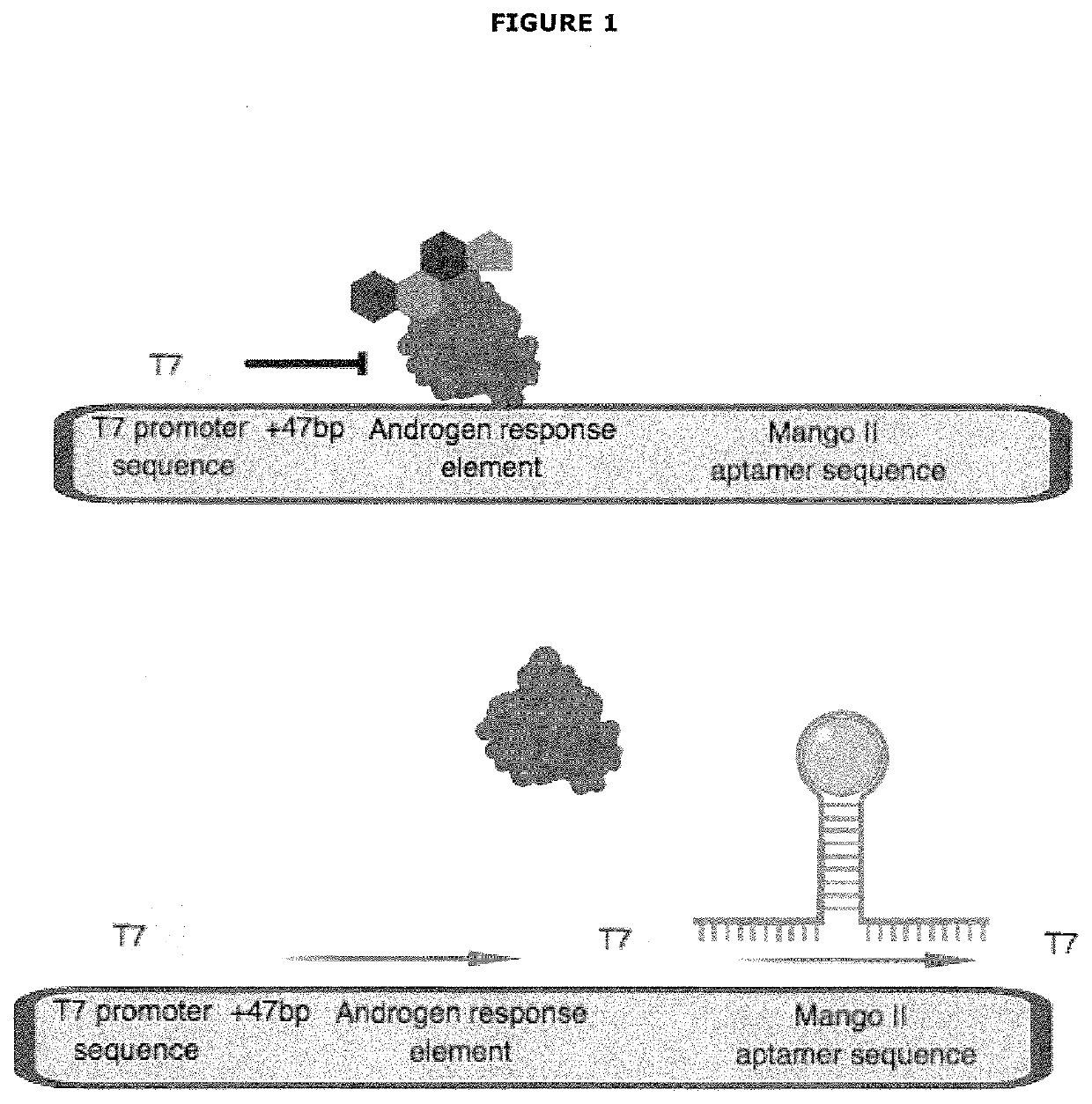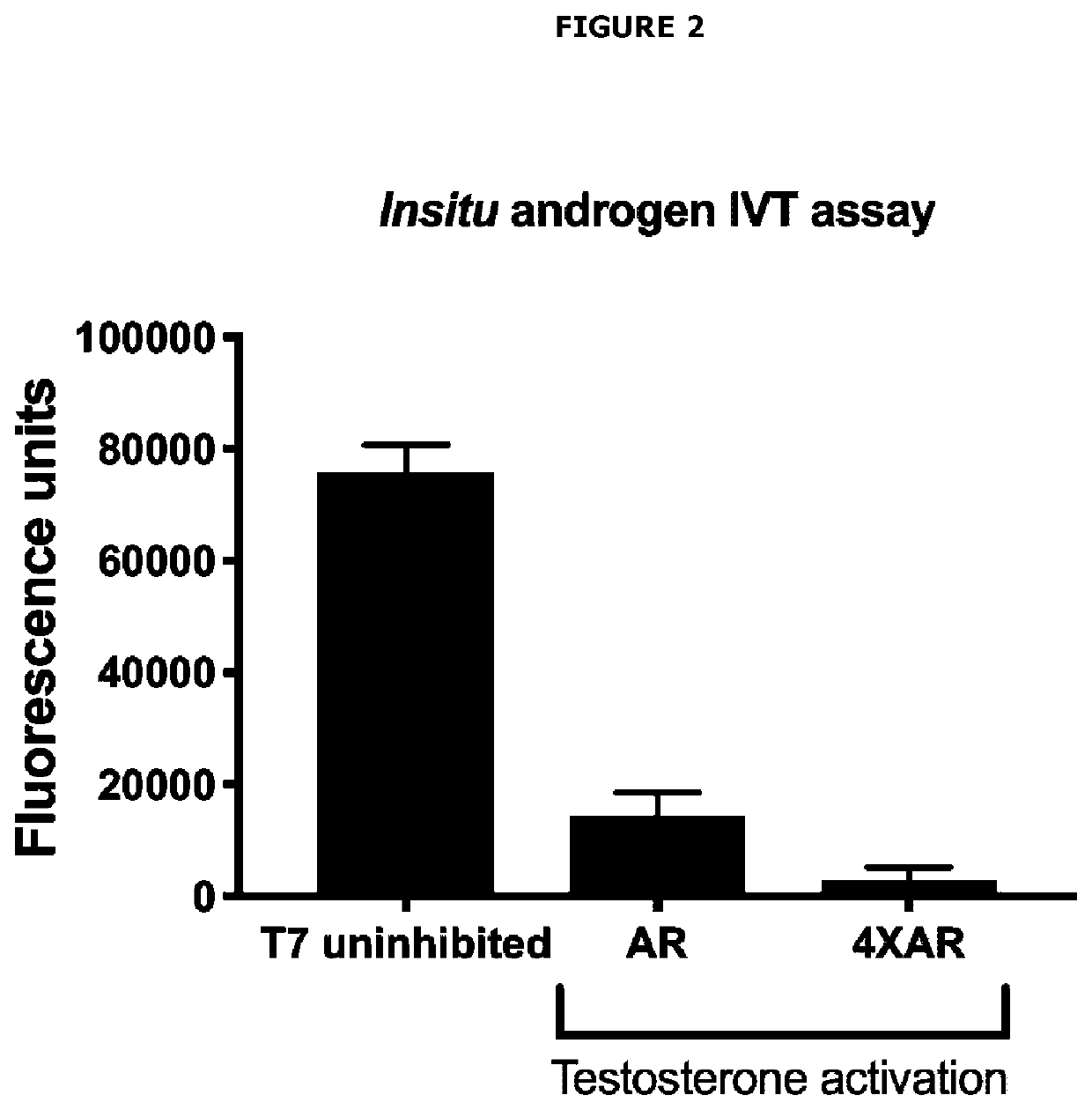Novel ligand assays
a technology of ligand assay and test kit, which is applied in the field of ligand assay, methods and test kits for detection of ligands, can solve the problems of complex preparation process, inability to detect ligands,
- Summary
- Abstract
- Description
- Claims
- Application Information
AI Technical Summary
Benefits of technology
Problems solved by technology
Method used
Image
Examples
example 1
Androgen Assay Prototype 1: Assay Architecture & Results
1.1 In Vitro Transcription Platform
[0525]Applicants initially developed an in vitro transcription platform include a DNA construct that encodes a T7 RNA consensus promoter sequence upstream of a tandem array of 3× androgen response elements (ARE) upstream of an RNA aptamer sequence for Mango II, combined with recombinant androgen receptor (AR), recombinant heat shock protein 90 (HSP90), T7 RNA polymerase, nucleoside triphosphates and a transcription buffer. The T7 promoter will drive a high level of RNA aptamer expression that will be detected by binding to fluorophore, Thiazole Orange 1—biotin (TO1). Inhibition of T7-driven aptamer expression will occur when ARE is bound by ligand-activated AR.
Androgen Response Element (ARE)
[0526]The androgen response element tested in these experiments was a tandem array of 3×ARE
[0527]Commercial recombinant AR has been tested from Sigma-Aldrich
[0528]The ...
example 2
Androgen Assay Prototype 2: Assay Architecture & Results
[0536]The concept of the Androgen Assay Prototype 2 is that a single protein RNA polymerase, such as T7 RNA polymerase, binds to its promoter sequence on a DNA template. The DNA template encodes the RNA aptamer Mango II sequence downstream of the promoter. A hormone response element (HRE) is located between the T7 promoter and the Mango II sequence. When a steroid hormone receptor (SHR) is added to the T7 in vitro transcription (IVT) reaction mix and activated by a receptor-specific ligand, the SHR binds to the HRE on the DNA template and in this bound position physically inhibits T7 RNA polymerase from transcribing the DNA into the RNA, and therefore no Mango II aptamer is formed. The formation of Mango II is detected by adding a specific fluorophore, such as TO1-biotin, to the reaction mix which binds to the Mango II aptamer. Upon binding to the Mango II aptamer, TO1 emits an excitation wavelength at 535 nm wavelength when ex...
example 3
Estrogen Assay Prototype 3: Assay Architecture & Results
[0559]In the above examples, AR / ARE was used as the example SHR / HRE. The following series of experiments used the defined reaction stoichiometry established for AR / ARE to show the applicability of the test to other SHRs, in this case ERα. The results presented below demonstrate that estradiol-activated ERα is able to suppress T7-mediated expression of RNA aptamer, Mango II.
TABLE 6Sequences Used in Prototype 3 for Detection of Estrogenic LigandsComponentSequenceT7 initiator sequenceTAATACGACTCACTATAG (SEQ ID NO: 1)15 bp fillerACTCTGGAGGAA (SEQ ID NO: 74)Primary ERECAGGTCAGCATGACCTG (SEQ ID NO: 79)MangoIIF30scaffold*TTGCCATGTGTATGTGGGTACGAAGGAGAGGAGAGGAAGAGGAGAGTACCCACATACTCTGATGATCCTTCGGGATCATTCATGGCAATCTAGGA(SEQ ID NO: 77)Mango IITACGAAGGAGAGGAGAGGAAGAGGAGAGTA (SEQ ID NO: 78)*single underline region, Mango II
[0560]The standard AR / ARE conditions that proved to be a successful detection test for testosterone were used, however AR...
PUM
 Login to View More
Login to View More Abstract
Description
Claims
Application Information
 Login to View More
Login to View More - R&D
- Intellectual Property
- Life Sciences
- Materials
- Tech Scout
- Unparalleled Data Quality
- Higher Quality Content
- 60% Fewer Hallucinations
Browse by: Latest US Patents, China's latest patents, Technical Efficacy Thesaurus, Application Domain, Technology Topic, Popular Technical Reports.
© 2025 PatSnap. All rights reserved.Legal|Privacy policy|Modern Slavery Act Transparency Statement|Sitemap|About US| Contact US: help@patsnap.com



